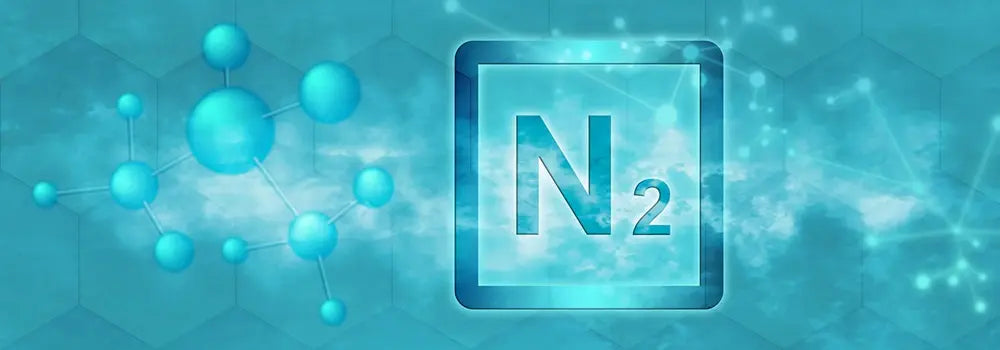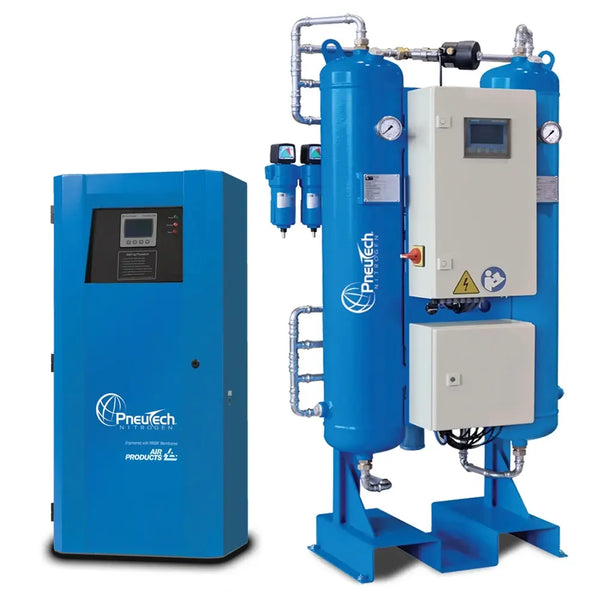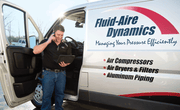Get the best nitrogen generator for your facility! If you use nitrogen in your industrial processes, an onsite nitrogen generator can save a lot of money and ensure that you never run out of the nitrogen you need. But there are a few things you should know about nitrogen generators before you buy.
What Is Nitrogen Used For?

Nitrogen gas (N2) is used for a variety of industrial and research applications. Nitrogen is a colorless and odorless gas that makes up 78% of the Earth’s atmosphere. It is also an inert gas, meaning it does not support combustion and does not react chemically with most substances. These properties make nitrogen gas extremely useful for a number of applications that require shielding or prevention of oxidation reactions such as combustion, corrosion, or spoilage.
Some industrial applications of nitrogen include:
- Controlled atmosphere storage of fruits, vegetables, and other food products (to prevent oxidation and spoilage).
- Food processing (especially inerting/blanketing for the production of wine, oils, soft drinks, and dairy products).
- Modified-atmosphere packaging (MAP) for meats, dairy products, wine, pre-cooked foods, and pharmaceutical products.
- Electronics production.
- Laser cutting and welding (as a shielding gas).
- Gas-assisted injection molding (GAIM).
- Foamed rubbers, plastics, and elastomers.
- Explosive applications (to provide a protective atmosphere).
- Chemical production.
- Aerosol can propellant.
How Pure Does Nitrogen Need to Be?

Different applications have varying levels of purity requirements. For example, electronics manufacturing and pharmaceutical applications often require very high purity nitrogen (up to 99.999%), whereas food packaging or tire inflation might require lower purity levels (around 95% to 99.5%).
Issues to consider when determining purity requirements for nitrogen:
- Consider how sensitive your process or product is to impurities. Processes that are highly sensitive to oxygen, moisture, or other contaminants will require higher-purity nitrogen to prevent quality issues.
- Many industries have established standards that specify the required purity levels for various processes. Reviewing these standards can provide a clear benchmark for what you need.
- If you're unsure about the specific purity level needed for your application, consulting with nitrogen generator suppliers or industry experts can provide valuable guidance.
| Typical Nitrogen Purity Requirements by Application* | |
|---|---|
| Application | Nitrogen Purity (%) |
| Food Packaging | 99.0 - 99.5 |
| Pharmaceuticals | 99.95 - 99.99 |
| Electronics Manufacturing | 99.99 - 99.999 |
| Metal Processing | 99.5 - 99.9 |
| Chemical Industry | 99.9 - 99.99 |
| Laboratory & Research | 99.99 - 99.999 |
| Laser Cutting | 99.95 - 99.99 |
| Pipeline Purging | 95.0 - 99.5 |
| Inerting/Blanketing | 99.0 - 99.5 |
* Based on typical industry guidelines; always refer to relevant standards, regulations, and application requirements for your specific application.
Argon may be left behind in the nitrogen separation process. Argon is also an inert gas and is naturally present in the atmosphere, though at much smaller levels than nitrogen and oxygen. Residual argon is generally less than 1.5% by mass in the final purified nitrogen product. Because argon is also inert, this is not a problem for the majority of applications; argon will provide the same shielding and inerting functions as nitrogen gas. The best onsite nitrogen generators can produce total inert gas with a purity of 99.999% or higher.
Choosing the Best Nitrogen Generator
Choosing the right nitrogen generator depends on your specific needs regarding nitrogen purity, flow rate, and cost considerations. Selecting the appropriate nitrogen generation technology for your application is essential to achieve the desired balance between nitrogen purity, efficiency, and operational cost. Tailoring the system to the application needs, the operating environment, and other requirements will ensure optimal system performance and maximize cost-effectiveness.
Types of Nitrogen Generators

There are two different technologies in use for onsite nitrogen generation:
- Membrane nitrogen generators: Work by separating nitrogen from other gasses in the air through a membrane filter. Air is pushed through this membrane, and due to the different sizes of gas molecules, nitrogen is separated from the rest. This type of generator is known for its simplicity, reliability, and low maintenance. They are best suited for applications that require nitrogen gas at lower purities (95% to 99.5%).
- PSA nitrogen generators: Use a process called Pressure Swing Adsorption. This method involves passing compressed air through a vessel filled with a carbon molecular sieve (CMS). Under pressure, CMS adsorbs oxygen and other gasses, allowing nitrogen to pass through as a purified product. Once the sieve becomes saturated with oxygen, the system switches to another vessel, allowing the saturated sieve to regenerate by releasing the adsorbed gasses. PSA generators are capable of producing high-purity nitrogen (up to 99.9995%) and are suitable for applications requiring high purity levels.
Read more: How Does a Nitrogen Generator Work?
Membrane vs. PSA Nitrogen Generation: Features, Benefits and Applications
| Membrane | Pressure Swing Adsorption (PSA) | |
|---|---|---|
| Advantages | Lower initial cost Simpler design Low maintenance requirements Safe for explosive environments (no electrical components) Modular & field scalable Suitable for remote deployment |
High purity levels Continuous production Suitable for high flow/high purity applications |
| Disadvantages | Lower purity Susceptible to oil contamination Efficiency affected by ambient conditions |
Higher initial investment Requires periodic replacement of adsorbent material More moving parts (e.g., valves) requiring maintenance |
| Purity Levels | 95% to 99.5% | Up to 99.999% |
| Flow Rates | Up to 15,000 cubic feet per hour (depending on purity) | Up to 130,000+ cubic feet per hour/2200+ cubic feet per minute (depending on purity) |
| Common Applications | Tire inflation (esp. in aviation) Oil & gas pipeline purging and well stimulation Fire prevention & suppression Manufacturing and food & beverage applications with lower purity requirements |
Laser cutting Metal processing/heat treating Welding & soldering Food packaging and preservation Pharmaceuticals Inerting/blanketing Laboratories & research facilities |
Factors to Consider When Selecting a Nitrogen Generator
When selecting a nitrogen generator, there are several key factors to consider to ensure you choose the right system for your needs.
These factors will help you evaluate different nitrogen generators based on your specific requirements to ensure operational efficiency and cost-effectiveness:
- Purity requirements: The first and foremost factor is the purity level of nitrogen required by your application. Different processes need different purity levels, ranging from 95% to 99.999%. Higher purity levels may require more sophisticated and expensive systems. PSA gas generators can deliver higher purity than membrane systems.
- Flow rate: Consider the volume of nitrogen your operation will consume. The flow rate, usually measured in standard cubic feet per minute (SCFM) or standard cubic feet per hour (SCFH), should match your consumption to avoid inefficiencies or shortfalls. PSA nitrogen generators have much higher flow capacity than membrane N2 generators.
- Operating environment: Ambient temperature, humidity, and cleanliness can affect the performance of the nitrogen generator, particularly membrane systems. On the other hand, the simple operation and low maintenance requirements of membrane N2 generators make them a better choice for remote or rugged conditions.
- Pressure requirements: Different applications may require nitrogen at different pressures. Ensure the generator you select can deliver nitrogen at the required pressure for your processes. If higher-pressure nitrogen is needed, a booster compressor may be needed to reach the required PSI.
- Cost of ownership: Look beyond the initial purchase price to understand the total cost of ownership, which includes maintenance, operating costs, and potential downtime. Energy efficiency plays a significant role in ongoing costs for nitrogen generation.
- Maintenance needs: Different generators have varying maintenance requirements. Consider how often maintenance is needed, the complexity of maintenance tasks, and the availability of service and parts. Membrane systems are generally lower maintenance than PSA systems.
- Reliability and durability: The reliability of the nitrogen generator is critical to avoid production downtimes. Look for systems with a proven track record of durability and reliability in similar applications.
- Size and space considerations: Consider the physical size of the nitrogen generator and the space available in your facility. Ensure that there is adequate space for installation, maintenance, and potential future expansion.
- Scalability: Consider whether the nitrogen generator can be scaled up to meet future growth or changes in demand. Some systems offer modular expansions, while others may require a complete replacement. If you are anticipating growth in the future, look for a model that is field-expandable and scalable.
- Manufacturer reputation and support: Finally, consider the reputation of the manufacturer and the level of support they offer. Good after-sales support, warranty terms, and accessibility of technical assistance can significantly affect your experience and the system's uptime.
Flow vs. Purity
When selecting a nitrogen generator, the most important questions to ask are:
- What is the volume of nitrogen I need to produce each hour, shift, or day? If your nitrogen consumption is variable, look at your peak demand.
- What is the nitrogen purity (or total inert gas purity) required by your application?
The tradeoff between flow rate and purity is a fundamental aspect of nitrogen generation systems. The higher the desired purity level of nitrogen gas, the longer the process takes and the lower the flow rate. This is because achieving higher purity requires the gas to spend more time in contact with the separation medium, whether that’s the adsorbent material in PSA systems or the membrane in membrane systems.
- In PSA technology, increasing purity levels might require slower cycling or a larger bed of adsorbent material to ensure that more oxygen and other undesired gasses are removed from the air.
- For membrane technologies, achieving higher purity levels involves adjusting the flow rate to allow more time for oxygen and other gasses to permeate through the membrane, leaving a higher concentration of nitrogen.
In other words, the same nitrogen generator can deliver much higher flow at lower purities (e.g., 95%-96%) than at higher purities. Delivering ultra-high purity nitrogen at 99.999% will severely curtail the flow rate. System specifications for nitrogen generators will provide the maximum flow rate for each purity level.
Nitrogen Generation System Components

Whether membrane or PSA, a nitrogen generator is part of a complete system that includes air compressors, piping, filtration, and other elements.
Components of a nitrogen generation system include:
- Air compressor: An industrial air compressor is an essential element of a nitrogen generation system to compress atmospheric air to the required pressure for nitrogen generation, typically between 100 and 150 PSI. Rotary screws, rotary vane, or reciprocating air compressors can all be used in nitrogen generation applications.
- Air receiver tank: An air receiver tank placed after the compressor cools the compressed air, allowing excess moisture to condense and drop out. It also ensures a consistent flow and pressure for the nitrogen generation process.
- Air dryer: Air dryers are essential to reduce the moisture content in the compressed air before it goes into the nitrogen generator. Removing moisture before nitrogen separation reduces strain on the system and helps to achieve higher nitrogen purity. Either refrigerated or desiccant dryers can be used; desiccant dryers may be recommended for applications requiring ultra-high-purity nitrogen.
- Pre-filtration: Inline filtration is used to remove oil and particulate matter from the air stream before nitrogen generation. The pre-filtration stage may include a combination of coalescing filters, particulate filters, and water separators.
- Nitrogen generator: At the core of the system, the nitrogen generator separates nitrogen from other air components using membrane or PSA technology.
- Booster compressor (optional): Output pressure for nitrogen systems is usually between 100-150 PSI, depending on technology type and inlet pressures. A booster compressor is sometimes used to raise the PSI of nitrogen for efficient storage or specific application needs. A multi-stage reciprocating compressor is capable of elevating pressure to 600 PSI or higher.
- Nitrogen buffer tank: Another tank is located after the nitrogen generator to store the generated nitrogen gas. This ensures a consistent supply of nitrogen and smooths out production fluctuations while maintaining consistent pressure and flow.
- Post-filtration (optional): Depending on the application and purity requirements, another bank of inline filters may be used after the nitrogen generator to remove any remaining impurities.
- Piping and distribution system: A piping system is needed to transport compressed air from the compressor to the nitrogen generator and deliver the nitrogen gas from the generator to the point of use. Piping for nitrogen systems must be rated for high-pressure applications. Fluid-Aire Dynamics prefers the Unipipe system for nitrogen applications.
- Control system: Control systems for nitrogen generators play a pivotal role in managing the operation and efficiency of the entire nitrogen generation process. These systems can range from simple manual controls to sophisticated automated solutions, allowing for precise regulation of pressure, flow rate, and purity of the produced nitrogen gas.
Components of a Membrane Nitrogen Generator

Membrane nitrogen generators are simple systems with no moving parts. Instead, they use hollow fiber membranes to allow passive diffusion of gas.
The core components of a membrane nitrogen generator are:
- Membrane module: The heart of the generator, this module contains hollow fiber membranes that selectively separate nitrogen from other gasses in the air based on molecular size and diffusion rates.
- Vent: Oxygen, carbon dioxide, water molecules, and other non-target gasses are vented back into the atmosphere.
- Purity adjustment system: A series of valves and controls designed to adjust the flow of air through the membrane module, enabling the operator to fine-tune the purity level of the nitrogen produced.
- Post-filtration: Some models come with integrated post-filtration to remove any remaining impurities from the nitrogen stream.
Components of a PSA Nitrogen Generator

PSA nitrogen generators are more complex in their operation.
The core components of a PSA twin-tower nitrogen generator include:
- Adsorption towers: Typically, two or more towers are filled with carbon molecular sieve (CMS) material, which adsorbs oxygen and other impurities under pressure, allowing nitrogen to pass through as a purified product.
- Pressure vessels: The adsorption towers are housed in durable pressure vessels to withstand the cycling pressures of the adsorption and regeneration phases, critical for the PSA process.
- Valves and control system: A network of valves controlled by an automated system that regulates the flow of air into the adsorption towers and directs the flow of purified nitrogen. This system also manages the pressure swing process, alternating between adsorption and regeneration phases to ensure continuous nitrogen production.
Nitrogen Generators from Fluid-Aire Dynamics
Fluid Air Dynamics is a proud distributor of membrane and PSA nitrogen generators from PneuTech. Proudly made in the USA, PneuTech nitrogen generators meet the highest possible standards for quality and performance.
PneuTech offers a range of system options and sizes for any nitrogen application:
- TNX series membrane nitrogen generators: A modular, field-scalable membrane system with low maintenance requirements, a small footprint, and integrated post-filtration and purity control.
- TN2 total: Our most popular membrane nitrogen production solution includes filtration, temperature, pressure, and flow control packages along with the membrane module(s).
- NGN series twin tower PSA: A high-performance twin tower PSA system capable of purities up to 99.999% and flow rates up to 2290 SCFM. Featuring generously sized adsorption towers for even and consistent N2 production and oversized pipes for low-pressure drop and energy efficiency.
- NGU UltraN2 high-purity series PSA: When the ultimate nitrogen purity is needed, the UltraN2 system delivers with purity beyond 99.999%. These systems deliver highly purified N2 rated to 50 ppm or 10 ppm oxygen content.
All PneuTech nitrogen generators are backed by PneuTech’s 5-year Pneu-Assure warranty:
- Five-year warranty on pressure vessels.
- Two-year bumper-to-bumper warranty on the entire unit.
- Guaranteed after-sales support.
- Industry-leading technical expertise.
If you’re ready to get started with onsite nitrogen generation, talk to the experts at Fluid-Aire Dynamics. Our nitrogen team will help you determine which type of nitrogen generator is right for you and design a total system that meets your application requirements.
Contact Fluid-Aire Dynamics for all of your nitrogen generation needs.
©2024 Fluid-Aire Dynamics, Inc. All Rights Reserved
